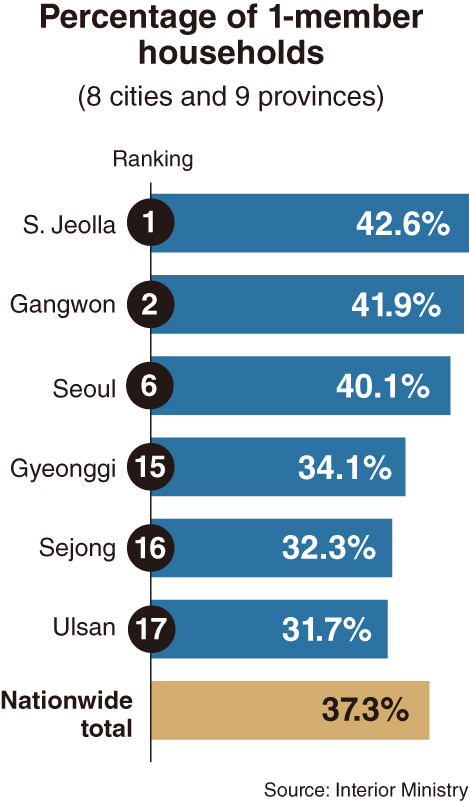SEJONG -- Ten years ago in July 2009, the number of single-person households was 6.08 million in South Korea, which took up 31.7 percent of the total households.
Compared to a mild increase in the number of households over the past decade, the number of single-person households has surged by more than two million to post 8.33 million as of July 2019.
According to the Ministry of Interior and Safety, they account for 37.3 percent of the total 22.31 million households across the country.
They exceeded two-member (5.04 million), three-member (4.0 million), four-member (3.68 million), five-member (960,000) and six-member households (208,000).
 |
The number of people residing alone has rapidly increased, including both the young generation as well as seniors. The so-called “yolo (You only live once)” syndrome is also gaining attention, that prioritizes enjoying the present, amid the falling marriage and rising divorce rates in Korea. (Hyundai MnSoft) |
Seoul topped the list among eight major cities accounting for 40.1 percent single-person households, at 1.72 million out of the total 4.3 million households in the capital.
“Residing alone is a trend not only among young and middle-aged Seoulites, but elderly people too,” said a government official.
Daejeon and Busan ranked second and third, respectively, accounting for 37 percent and 36.6 percent, respectively. Gwangju was fourth with 35.9 percent.
South Jeolla Province recorded the highest portion of one-member households among the eight cities and nine provinces with 42.6 percent, followed by Gangwon Province at 41.9 percent. The next rankers were South Chungcheong, North Gyeongsang and Jeju provinces at 40.4 percent each.
This shows that a growing number of seniors are residing alone in rural areas as they lost their spouse and their married children moved to metropolitan cities.
In contrast, Gyeonggi Province ranked last among the nine provinces with 34.1 percent, that has new residential townships, where many two-member households or newlyweds moved to from Seoul.
Ulsan and Sejong ranked last and second-last among the 17 major cities and provinces with 31.7 percent and 32.3 percent.
The two cities have the lowest percentage of seniors in the nation -- 16th for Ulsan and 17th for Sejong -- aged 65 or over, as they hold manufacturing- and administrative-oriented jobs, respectively.
 |
(Graphic by Han Chang-duck/The Korea Herald) |
Demographic research analysts share the view that the trend toward more single-person households is spreading rapidly across major cities and rural areas. They cite low fertility rates, rising divorce rates, falling marriage rates and the movement of young people born in farming districts to urban areas.
In July 2009, four-member households accounted for 22.2 percent (4.25 million) of the total 19.05 million households nationwide.
It was the second-greatest by proportion, trailing single-person households whose number and percentage out of the total households posted 6.08 million and 31.7 percent, respectively.
The third- and fourth-largest were two-member (18.8 percent) and three-member (18.7 percent) households 10 years ago.
In contrast, in July 2019, the number of four-member households was 3.68 million, declining by 13.4 percent, or 570,000, from a decade earlier.
Further, the percentage of four-member households slid to fourth place with their portion standing at only 16.5 percent out of the total last month.
The number of two-member and three-member households increased to 5.04 million and four million, up about 40 percent and 10 percent from a decade prior.
On the basis of percentage, the two-member and three-member households ranked second and third, at 22.6 percent and 17.9 percent.
Like those of four residents, the number of five-member households dropped 20.6 percent from 1.21 million in July 2009 to 960,000 in July 2019.
The number with six-member households fell from 280,000 to 208,000 units, which is quite different from the 1960s-80s when joint families were common.
Data showed that the number of four-member households was initially overtaken by two-member homes in November 2013, from 4.12 million to 4.13 million.
In addition, the three-member households also overtook those of four members in February 2017, when the respective numbers posted 3.93 million and 3.92 million, respecectively.
By Kim Yon-se (
kys@heraldcorp.com)






![[From the Scene] Monks, Buddhists hail return of remains of Buddhas](http://res.heraldm.com/phpwas/restmb_idxmake.php?idx=644&simg=/content/image/2024/04/19/20240419050617_0.jpg)


